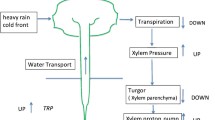Summary
In tissue slices of tomato (Solanum lycopersicum L.) sieve tube membrane potentials (Em) were measured by use of glass microelectrodes. In internode discs, the potential differences (pd) of phloem cells near the cut surface fell into two distinct categories with average values of −66 and −109 mV. More distant from the cut surface the values decreased to averages of −71 and −140 mV. These pds were associated with phloem parenchyma cells and sieve tube/companion cell complexes, respectively. In petiole strips, pds were recorded from cells which were identified by iontophoretic injection of fluorescent dye. Averages in two different bathing media, were −140/−146mV, −149/−152mV, and −70/−68mV for sieve tubes, companion cells, and phloem parenchyma cells, respectively. The membrane potentials recorded from sieve tubes were transiently reduced upon sucrose addition. Reduction by CCCP and KCN was more permanent. Sieve tube Ems recovered more slowly from potassium than from sucrose-induced depolarizations. Light/ dark (L/D) responses were minute (±3 mV). The limitations of the present experimentation are evaluated with special reference to the question as whether the recorded Ems represent sieve tube membrane potentials occurring in the intact plant.
Similar content being viewed by others
Abbreviations
- CCCP:
-
carbonyl cyanide m-chlorophenylhydrazone
- D:
-
dark(ness)
- Em :
-
membrane potential
- L:
-
light
- LYCH:
-
Lucifer yellow CH
- pd:
-
potential difference
- SE:
-
standard error
References
Behnke H-D (1975) Companion cells and transfer cells. Structure, function, development of transfer cell. In: Aronoff S et al (eds) Phloem transport. Plenum Press, New York London, pp 153–175
Cheeseman JM, Pickard BG (1977) Electrical characteristics of cells from leaves ofLycopersicon. Can J Bot 55: 497–510
Contardi PJ, Davis RF (1978) Membrane potential inPhaeoceros laevis. Plant Physiol 61: 164–169
Daie J (1987) Sucrose uptake in isolated phloem of celery is a single saturable transport system. Planta 171: 474–482
Delrot S, Bonnemain J-L (1985) Mechanism and control of phloem transport. Physiol Vég 23: 199–220
Erwee MG, Goodwin PB, van Bel AJE (1985) Cell-cell communication in the leaves ofCommelina cyanea and other plants. Plant Cell Environ 8: 173–178
Evert RF, Eschrich W, Heyser W (1978) Leaf structure in relation to solute transport and phloem loading inZea mays L. Planta 138: 279–294
Fensom DS (1975) Work with isolated phloem strands. In: Zimmermann MH, Milburn JA (eds) Transport in plants, vol 1, phloem transport. Springer, Berlin Heidelberg New York, pp 223–244 [Pirson A, Zimmermann MH (eds) Encyclopedia of plant physiology, new series, vol 1]
Fisher DG, Evert RF (1982) Studies in the leaf ofAmaranthus retroflexus (Amaranthaceae): ultrastructure, plasmodesmatal frequency and solute concentration in relation to phloem loading. Planta 155: 377–387
Fromm J, Eschrich W (1988) Transport processess in stimulated and non-stimulated leaves ofMimosa pudica. II. Energesis and transmission of seismic stimulations. Trees 2: 18–24
Giaquinta RT (1977) Possible role of pH gradient and membrane ATPase in the loading of sucrose into the sieve tubes. Nature 264: 369–370
—, (1983) Phloem loading of sucrose. Annu Rev Plant Physiol 34: 347–387
Gifford RM, Evans LT (1981) Photosynthesis, carbon partitioning, and yield. Annu Rev Plant Physiol 32: 485–509
Goodwin PB (1983) Molecular size limit for movement in the symplast of theElodea leaf. Planta 57: 124–130
—, Erwee MG (1985) Intercellular transport studied by micro-injection. In: Robards AW (ed) Botanical microscopy. Oxford University Press, Oxford, pp 335–358
Gradmann D, Mayer W-E (1977) Membrane potentials and ion permeabilities in flexor cells of the laminar pulvini ofPhaseolus coccineus L. Planta 137: 19–24
Komor E (1983) Phloem loading and unloading. Prog Bot 45: 68–75
—, Ohrlich G (1986) Sugar-proton symport: from single cells to phloem loading. In: Cronshaw J et al (eds) Phloem transport. Alan R Liss, New York, pp 53–65
Malek F, Baker DA (1977) Proton co-transport of sugars in the phloem loading. Planta 135: 297–299
— — (1978) Effect of fusicoccin on proton co-transport of sugars in the phloem loading ofRicinus communis L. Plant Sci Lett 11: 233–239
Milburn JA (1975) Pressure Flow. In: Zimmermann MH, Milburn JA (eds) Transport in plants, vol 1, phloem transport. Springer, Berlin Heidelberg New York, pp 328–353 [Pirson A, Zimmermann MH (eds) Encyclopedia of plant physiology, new series, vol 1]
Overall RL, Gunning BES (1982) Intercellular communication inAzolla roots. II. Electrical coupling. Protoplasma 111: 151–160
Palevitz BA, Hepler PK (1985) Changes in dye coupling of stomatal cells ofAllium andCommelina demonstrated by microinjection of Lucifer yellow. Planta 164: 473–479
Prins HBA, Harper JR, Higinbotham N (1980) Membrane potentials ofVallisneria leaf cells and their relation to photosynthesis. Plant Physiol 65: 1–5
Samejima M, Sibaoka T (1983) Identification of the excitable cells in the petiole ofMimosa pudica by intracellular injection of procion yellow. Plant Cell Physiol 24: 33–39
Sibaoka T (1962) Excitable cells inMimosa. Science 137: 226
Stewart WW (1981) Lucifer dyes-highly fluorescent dyes for biological tracing. Nature 292: 17–21
Tucker EB (1982) Translocation in the staminal hair ofSetcreasea purpurea. I. A study of cell ultrastructure and cell to cell passage of molecular probes. Protoplasma 113: 193–202
van Bel AJE, Koops AJ (1985) Uptake of14C-sucrose in isolated minor vein networks ofCommelina benghalensis L. Planta 164: 362–369
van der Schoot C, van Bel AJE (1989) Architecture of the internodal xylem of tomato (Solatnum lycopersicum L.) with reference to longitudinal and lateral transfer. Am J Bot (in press)
Wright JP, Fisher DB (1981) Measurement of the sieve tube membrane potential. Plant Physiol 67: 845–848
Author information
Authors and Affiliations
Rights and permissions
About this article
Cite this article
van der Schoot, C., van Bel, A.J.E. Glass microelectrode measurements of sieve tube membrane potentials in internode discs and petiole strips of tomato (Solanum lycopersicum L.). Protoplasma 149, 144–154 (1989). https://doi.org/10.1007/BF01322986
Received:
Accepted:
Issue Date:
DOI: https://doi.org/10.1007/BF01322986



